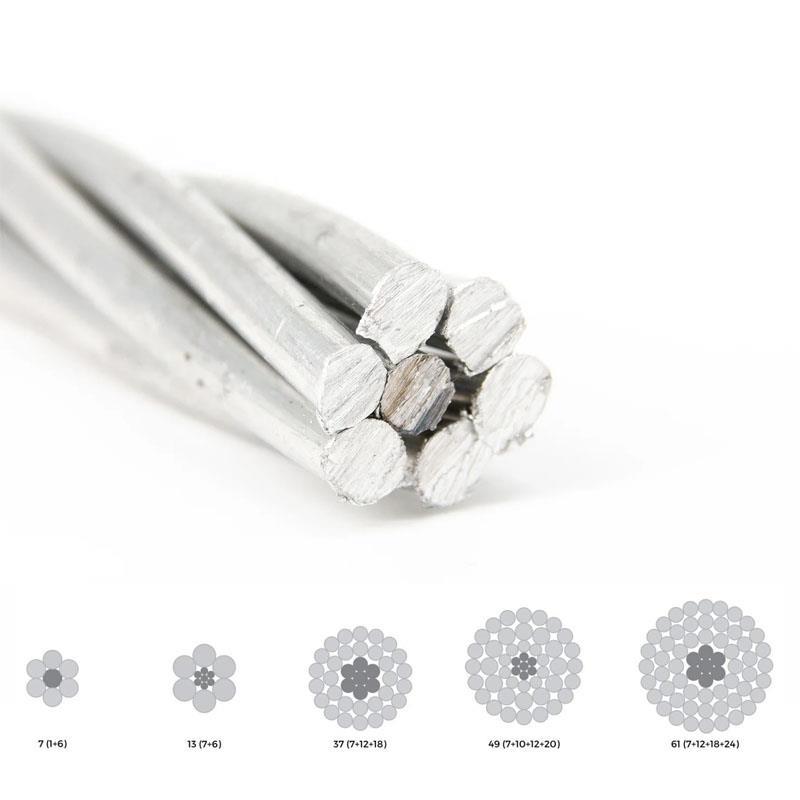Introduction
ACSR (Aluminium Conductor Steel-Reinforced) is a high-capacity, high-strength stranded conductor widely used in overhead power lines. It combines the lightweight and excellent conductivity of aluminum with the mechanical strength of steel. The outer strands are made of high-purity aluminum, known for its conductivity, light weight, and corrosion resistance, while the steel core provides additional strength to support the conductor’s weight and minimize sag.
Design and Components
Aluminum Strands: In the United States and Canada, the aluminum alloy used is typically 1350-H19, while elsewhere, 1370-H19 is common. Both alloys have 99.5%+ aluminum content, ensuring high conductivity and durability.
Steel Core: The steel core, usually galvanized to prevent corrosion, enhances mechanical strength. It reduces elastic and inelastic deformation caused by mechanical loads (e.g., wind, ice) and thermal expansion, resulting in less sag compared to all-aluminum conductors.
Steel Core Types:
Galvanized Steel (GA2): Regular strength with a Class A zinc coating.
Galvanized Steel (GA5): Ultra-high strength with a Class A zinc coating.
Zinc-5% Aluminium Mischmetal (MA2): Regular strength with improved corrosion resistance.
Aluminium-Clad Steel (AW): Offers enhanced corrosion protection and conductivity, ideal for coastal applications.
Properties
ACSR combines the best properties of aluminum and steel:
Conductivity: High, due to the aluminum strands carrying most of the electrical current.
Mechanical Strength: The steel core provides high tensile strength, allowing for greater tension and reduced sag.
Thermal Expansion: Lower than all-aluminum conductors, minimizing sag under load.
Operating Temperature: Limited to 75°C due to aluminum annealing. For higher temperatures, Aluminium-Conductor Steel-Supported (ACSS) conductors are recommended.
Effects
Skin Effect: At higher AC frequencies, current flows near the surface of the conductor, increasing resistance. This effect is beneficial as it concentrates current in the low-resistivity aluminum.
Proximity Effect: Currents in nearby conductors constrain current distribution, increasing effective AC resistance.
Sizing and Lay
ACSR conductors are available in various sizes, denoted by the number of aluminum and steel strands (e.g., 72/7). The outer strands typically have a right-hand lay in the USA. For example, a conductor with 72 aluminum strands and 7 steel strands is referred to as a 72/7 ACSR conductor.
Example Sizes:
Grosbeak: 26 aluminum strands, 7 steel strands, total conductor area of 322.3 mm².
Egret: 30 aluminum strands, 19 steel strands, same aluminum size but different mechanical characteristics.
Performance Factors
ACSR’s performance in overhead power lines depends on several factors:
Ampacity Ratings: Determined by wind speed, sun intensity, ambient temperature, and maximum conductor temperature. Higher emissivity coatings can improve heat dissipation, increasing ampacity.
Mechanical Loading: The steel core’s high tensile strength allows ACSR to withstand mechanical loads from wind and ice, minimizing sag and maintaining structural integrity.
Applications
ACSR is widely used in high-voltage overhead power lines due to its combination of strength and conductivity. Variations like aluminum-clad steel are preferred in coastal areas for better corrosion resistance. It is ideal for applications requiring high mechanical strength and conductivity, such as long-distance power transmission.
Special Designs
Trapezoidal Wire (TW): Uses trapezoidal-shaped aluminum strands to increase cross-sectional area or reduce overall diameter.
Self-Damping (SD): Designed to control wind-induced vibration through internal damping.
Aluminium-Conductor Steel-Supported (ACSS): Uses fully annealed aluminum for high-temperature operations.
Twisted Pair (TP): Reduces ice/wind galloping and Aeolian vibration by twisting sub-conductors.
Splicing
Splicing ACSR conductors is critical for maintaining integrity and performance. Most splices are compression-type (crimps), offering good strength and conductivity. Automatic splices are faster to install and are often used during storm restoration. Special splices are required for SD-type conductors due to their unique construction.

